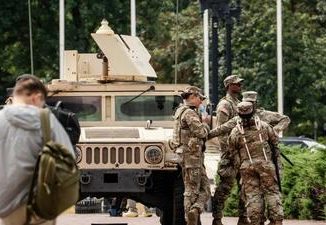
Meteorologists have argued that the National Oceanic and Atmospheric Administration (NOAA) and National Weather Service (NWS) did their jobs well during the devastating Texas flash floods — and even had “extra” staff on hand for the storm — despite Democrats’ claims that the Trump administration’s cuts to the agencies contributed to the loss of life over the holiday weekend.
| Published July 9, 2025
As historic flash floods devastated Central Texas over the July 4 weekend, attention quickly turned to the National Weather Service (NWS). While some critics blamed long-standing staffing cuts—traced back to the Trump administration—meteorologists and agency insiders insist the warnings were accurate and timely. Still, the episode has reignited a national debate about how budget constraints may hamper future disaster response.
NWS Performance: “They Did Their Job”
In the immediate aftermath, meteorologists across the board agreed: the NWS issued multiple flash flood warnings, including a rare “flash flood emergency”, well before conditions became catastrophic in the Austin and San Antonio areas.
According to Matt Lanza, a meteorologist who has previously criticized NWS budget cuts, “There is absolutely nothing to suggest that current staffing or operations played any role in what happened.” He emphasized that the flooding was caused by “an extreme, localized deluge” that exceeded normal predictive models.
NWS union representative Tom Fahy supported that view, noting that the New Braunfels office (which covers Central Texas) had more meteorologists on duty than usual—up to five instead of two, all working overtime.
“We had a full complement. No one was left scrambling,” Fahy said.
Forecast Accuracy vs. Rainfall Extremes
While the warnings were issued hours in advance, the severity of the rainfall—which dumped over 10 inches in some areas in less than 12 hours—caught many residents off guard. Wired reports that while forecasts captured the general risk of flooding, pinpointing such concentrated and historic rainfall remains a scientific challenge.
“The weather models did show risk, but we were dealing with a storm system that rapidly intensified and stalled in a narrow band,” one NWS meteorologist told Wired.
This has led many experts to call for continued investment in high-resolution models and better communication systems for emergency warnings.
The Staffing and Budget Debate
Despite praise for the NWS response, scrutiny remains over the agency’s long-term capacity. During the Trump administration, the NWS experienced staffing reductions of up to 17% in some offices, largely through attrition and hiring freezes.
While these did not affect the July 4 response directly, critics argue the agency is now stretched thin nationwide. A 2024 Government Accountability Office report warned that unfilled vacancies could “impair coordination during multi-day or multi-state events.”
“Just because they had enough staff for this one event doesn’t mean they always will,” said a former NOAA official.
Others, including Republican lawmakers, have defended the budget choices, emphasizing that “bureaucracy bloating” is not the same as frontline cuts and that actual field offices, like New Braunfels, maintained robust operations.
🔍 Resulting Effects of the NWS Response to Texas Floods
✅ 1. Public Trust in NWS Reinforced (in the short term)
-
The NWS successfully issued multiple flood alerts—including high-level “flash flood emergencies”—which likely prevented more deaths.
-
Public confidence in local weather offices (especially New Braunfels) was strengthened, as many residents received alerts in time to seek safety.
-
Meteorologists and emergency managers credited the staff’s readiness and technical forecasting for effective warning delivery.
⚖️ 2. Renewed Debate Over Federal Weather Budget Cuts
-
Despite the effective response, the event reignited national scrutiny over Trump-era staffing cuts to the NWS.
-
Politicians, climate advocates, and media outlets questioned whether similar success could be replicated during future, larger-scale disasters.
-
Some Democratic lawmakers are now proposing new funding bills to bolster NWS staffing, weather modeling, and forecasting infrastructure.
🧪 3. Call for Investment in Forecasting Technology
-
The inability to predict the extreme rainfall totals—despite issuing general risk forecasts—highlighted the limits of current weather models.
-
Wired and others called for greater investment in high-resolution modeling, especially to keep up with climate-driven extremes.
-
NOAA and academic partners have proposed new AI-enhanced forecasting initiatives that would require federal support.
📉 4. Exposure of Staffing Vulnerabilities Nationwide
-
Though the New Braunfels office was well-staffed, many other NWS offices still face persistent vacancies and overtime burnout.
-
Internal reports and whistleblowers warn that nationwide gaps could lead to slower responses in future weather events.
-
There are now calls for reforming the NWS hiring process, which has reportedly become slow and bogged down by bureaucracy.
🌪️ 5. Urgency for Public Warning System Improvements
-
Some residents reported confusion over the severity of warnings—mistaking “flash flood emergency” for standard alerts.
-
Communication experts urge a revamp of how warnings are phrased and distributed, including push alerts, social media, and multilingual systems.
-
FEMA and local governments are reassessing outreach strategies, especially in high-risk, low-income areas.
🏛️ 6. Political Fallout and Policy Reactions
-
The debate has become politically charged, with Republicans defending the Trump-era cuts as “non-essential trims” and Democrats warning of long-term danger.
-
Legislative hearings are being scheduled to evaluate the broader impact of weather-related agency budget constraints.
-
Texas officials are considering state-level upgrades to flood readiness infrastructure, forecasting coordination, and public alert systems.
 Bottom Line:
Bottom Line:
The catastrophic floods in Texas over the July 4 weekend served as both a test and a testament to the National Weather Service. Despite facing years of budget tightening and staffing challenges, local NWS offices responded with professionalism, accuracy, and urgency—issuing multiple timely alerts that likely saved lives. For this event, the system worked.
However, the success of this response should not be mistaken for a guarantee. The growing unpredictability of extreme weather, driven in part by climate shifts, will demand more from meteorologists, forecasters, and public warning systems in the years ahead. Experts widely agree: without sustained investment in staffing, forecasting technology, and communication tools, the ability to meet the next crisis with equal effectiveness is far from certain.
In the aftermath of this disaster, one truth is clear—America’s weather infrastructure may have passed this test, but future resilience will depend on whether lessons learned now are turned into action before the next storm hits.





Be the first to comment